Address
304 North Cardinal
St. Dorchester Center, MA 02124
Work Hours
Monday to Friday: 7AM - 7PM
Weekend: 10AM - 5PM
Address
304 North Cardinal
St. Dorchester Center, MA 02124
Work Hours
Monday to Friday: 7AM - 7PM
Weekend: 10AM - 5PM
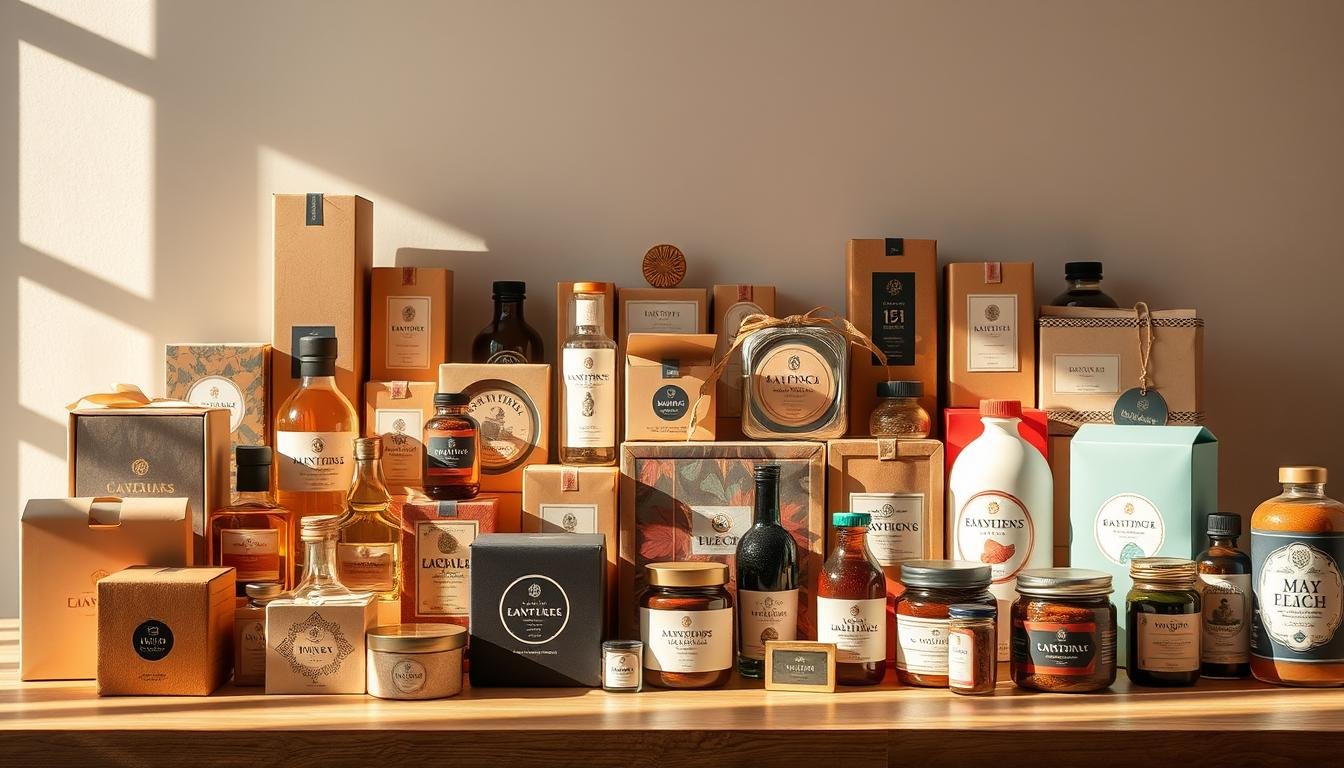
Do you know how much packaging affects your product’s success? The packaging is often the first thing customers see. It shapes their opinion and buying choices.
Effective packaging does more than protect your product. It also shows off your brand. With so many product packaging options, picking the right one can be hard.
Think about the material, design, and how it works. Your packaging should match your brand and appeal to your audience.
Your product’s packaging is often the first thing customers see. It’s key to your marketing strategy. So, it’s vital to know how packaging helps your product succeed.
Product packaging does a lot. It protects, preserves, and presents your product. Protection is clear, keeping your product safe during transport and display. Preservation is also key, especially for items that spoil or break easily.
But packaging does more than just protect. It also presents your product in a way that grabs attention. Good packaging can make your product stand out and show off your brand’s values.
Branding is a big part of packaging. It helps make your product unique and keeps customers coming back. Good packaging should show off your brand’s personality and message.
« The packaging is part of the product, and it’s the first thing the customer sees. »
Using your brand’s visual elements like logos and colors makes your packaging stand out. It helps create a strong brand image that customers will remember.
What customers expect from packaging is changing. They want packaging that’s good for the environment. This means looking for options that are sustainable and eco-friendly.
Meeting these expectations can make your packaging better. It protects your product and shows you care about the environment. This can make customers happier and more loyal to your brand.
Packaging materials are key to protecting your products and making them look good. The right material can greatly improve the customer’s experience and the product’s environmental impact.
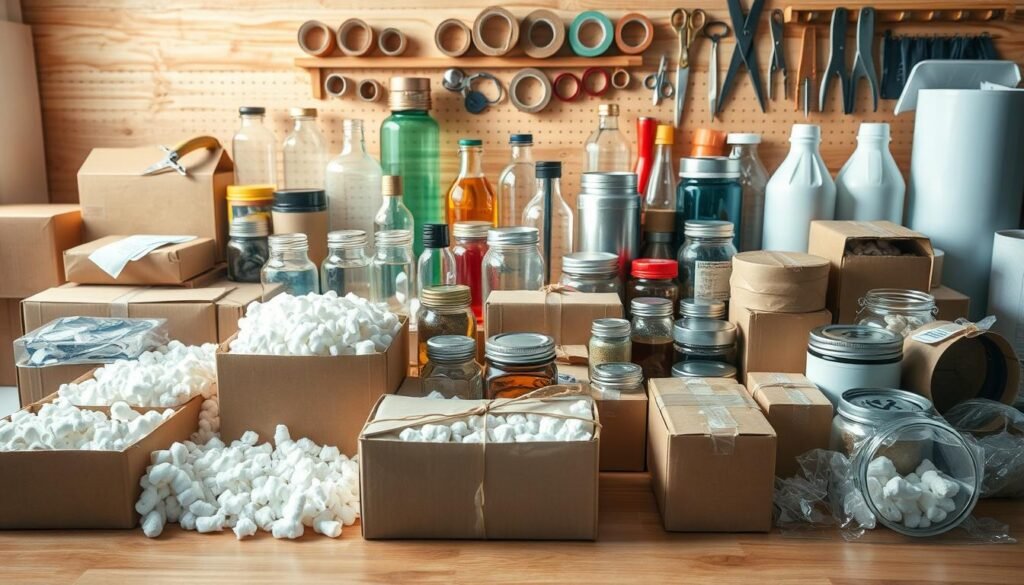
The debate between paper and plastic packaging is ongoing. Paper packaging is good for the environment because it’s biodegradable and recyclable. But, it might not be as strong as plastic in some cases.
Plastic packaging is versatile and can be used for many products. It’s light and can be very durable. Yet, plastic isn’t biodegradable and can harm the environment if not thrown away correctly.
There’s a growing trend towards eco-friendly packaging. This includes materials that break down naturally, can be recycled, or come from sustainable sources. Examples are packaging made from plants, recycled paper, and bioplastics.
Glass packaging is great for products needing high purity, like food and drinks. It’s non-porous and can be recycled. But, glass is heavy and can be pricey to ship.
Metal packaging, like tin cans and aluminum, is strong and protects well against light and oxygen. It’s often used for food and drinks. Metal can also be recycled, making it a green choice.
| Material | Advantages | Disadvantages |
|---|---|---|
| Paper | Biodegradable, recyclable | Less durable than plastic |
| Plastic | Versatile, lightweight, durable | Not biodegradable, contributes to pollution |
| Glass | Non-porous, recyclable | Heavy, expensive to transport |
| Metal | Durable, recyclable | Can be expensive |
In a crowded marketplace, your product’s packaging can be the key difference. When designing product packaging, think about what affects how people see and buy your product.
Colors can make us feel certain ways and send messages. In custom product packaging, picking the right color is crucial. For example, red means energy and urgency, while blue means trust and calm.
The typefaces on your packaging do more than help people read. They’re key to your brand’s look. The right font can make your packaging look better and share your brand’s message.
Your packaging shows who you are as a brand. To make a lasting impression, you need a unique brand identity that speaks to your audience. It’s not just about looks; it’s about the experience you create.
To make this happen, think about these points:
By focusing on these areas, you can make packaging that not only catches the eye but also connects with your customers.
Understanding the financial side of packaging is key to making smart choices for your business. Good packaging protects your product and keeps costs down.
To plan your packaging budget, think about the material type, how much you need, and the cost from suppliers. Paper, plastic, glass, and metal vary in price. Choose based on your product’s needs and your budget.
For fragile items, you might need to spend more on glass or metal. These are pricier but offer better protection.
It’s important to find a balance between quality and cost. Cutting costs by using cheaper materials can harm your brand’s image.
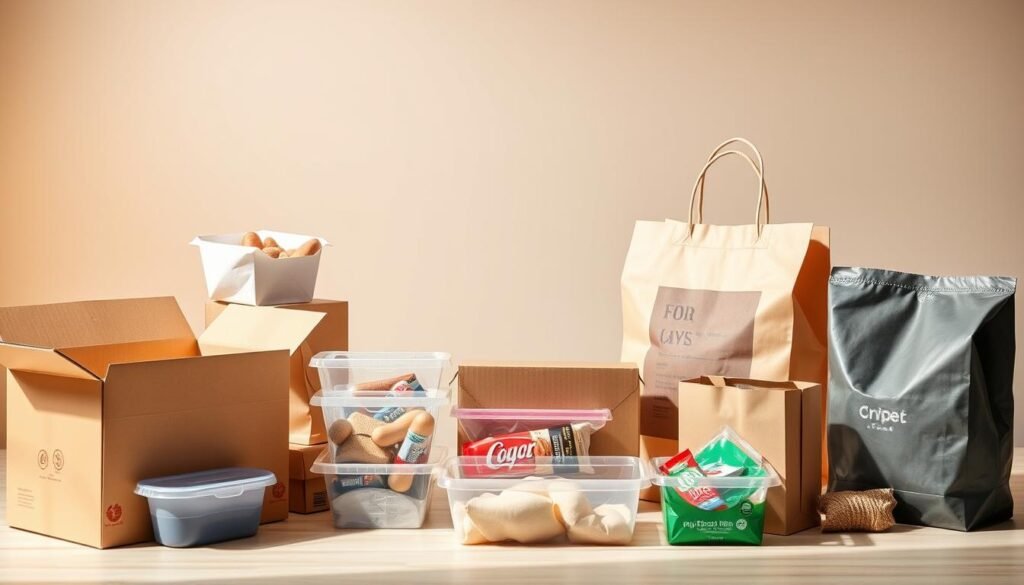
Investing in quality materials can boost your brand and customer satisfaction. Look into eco-friendly packaging options. They’re good for the planet and can save money in the long run.
To find affordable suppliers, compare different vendors. Look for those offering best packaging solutions at good prices.
By carefully choosing your suppliers, you can keep packaging costs low without sacrificing quality.
Understanding packaging regulations is key for businesses to stay legal and avoid trouble. It’s as important as choosing the right design and materials for your products.
Food packaging must be safe. Laws differ by country, but in the UK, you must follow EU rules, even after Brexit. This ensures packaging doesn’t harm food, keeping consumers safe.
Key considerations include:
Labeling is also heavily regulated. You must clearly state the product’s ingredients, nutritional info, and allergens. For example, the UK’s Food Information Regulations require clear labels to protect health.
Accurate labeling helps follow the law and builds trust with customers. Keeping up with labeling law changes is vital to avoid breaking the rules.
Environmental laws on packaging are getting tougher. The UK’s Packaging Waste Regulations require recycling of packaging waste. If you handle over 50 tonnes of packaging yearly and have a certain turnover, you must comply.
To meet these standards, you can:
Following these rules helps avoid legal problems and supports eco-friendly packaging. Keeping up with regulatory changes is essential for success in the packaging industry.
In the world of e-commerce, packaging is key to a great customer experience. It’s vital to think about how your packaging can make your brand stand out and keep customers happy.
Durability is crucial when creating packaging for online sales. Your packaging must survive shipping to ensure products arrive safely. Choose the right materials and design to protect against shocks.
Use custom inserts or void fill to keep items stable during shipping. Also, make sure your packaging is sealed well and shows if it’s been tampered with. This builds trust with your customers.
Nowadays, people care more about the environment, and so do businesses. They’re using eco-friendly packaging solutions like recyclable materials and biodegradable options. Some even choose to use less packaging.
Choosing sustainable packaging helps the planet and boosts your brand’s image. Share your green efforts with your customers through your packaging or marketing.
The unboxing experience is a big deal in e-commerce. It’s a chance to amaze your customers and make a lasting impression. Think about adding personal touches, unique designs, or surprise gifts to your packaging.
By focusing on the unboxing, you can make a simple purchase memorable. This builds loyalty and encourages people to come back.
When you think about your product’s environmental impact, packaging is key. The packaging industry is a big waste maker worldwide. It’s a big area for businesses to focus on to cut their environmental harm.
Eco-friendly packaging is more than a trend; it’s essential for companies wanting to be more sustainable. By choosing sustainable packaging, businesses can lessen their environmental harm.
Reducing waste starts with smart packaging design. This means using less material, choosing recyclable or biodegradable options, and making packaging reusable. For example, switching from plastic to paper or offering refill options for some products.
Case in point: Some companies have cut their waste by using less material in their packaging. They keep the protection and brand look without using too much.
| Packaging Material | Environmental Impact | Sustainability Score |
|---|---|---|
| Plastic | High | 2/10 |
| Paper | Low | 8/10 |
| Glass | Medium | 6/10 |
New, green packaging materials are vital for lessening environmental harm. New stuff like bioplastics, edible packaging, and mushroom-based materials are becoming popular.
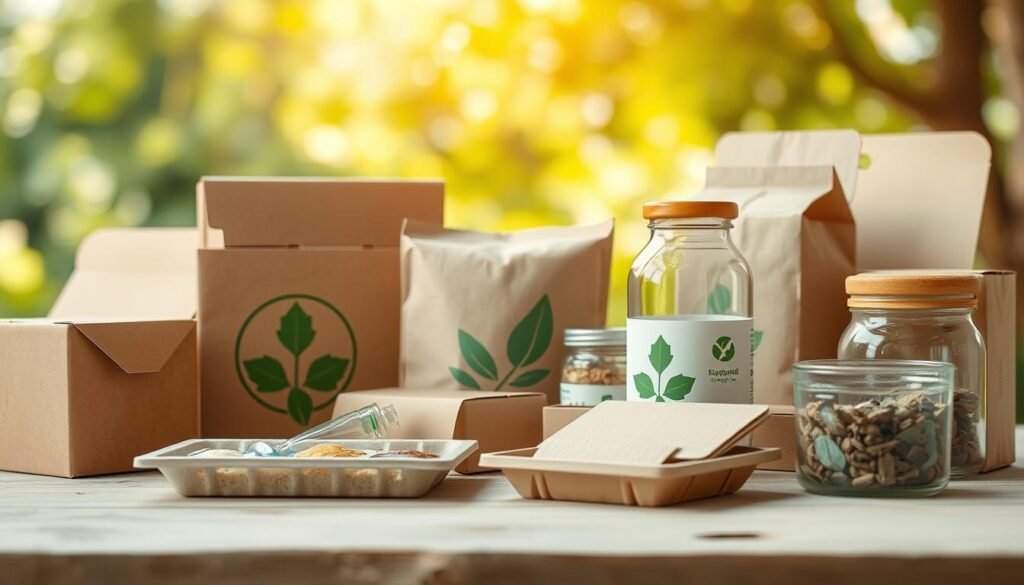
More and more people want eco-friendly packaging. A survey showed most consumers think about packaging’s environmental impact when buying. This change in what people want is pushing companies to use greener packaging.
To meet this need, businesses must use sustainable packaging and tell customers about it. Being open and honest is crucial for winning over eco-aware shoppers.
Product packaging is changing fast. People care more about the planet, and tech is getting better. This means packaging is evolving to meet these new needs.
Minimalist packaging is becoming popular. Minimalist packaging uses simple designs and fewer materials. It’s good for the planet and makes brands look classy.
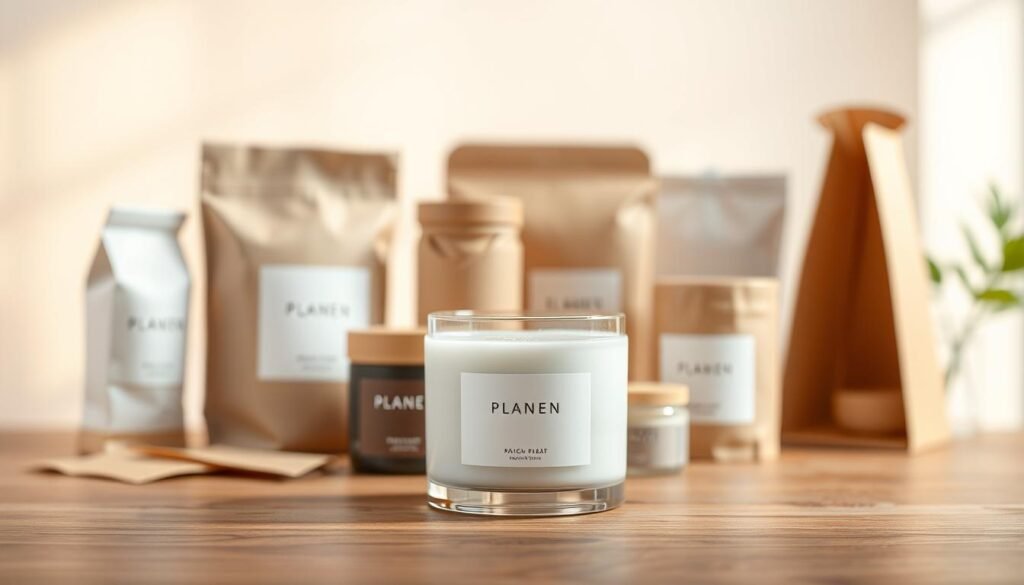
Technology is making packaging smarter. Interactive and smart packaging uses QR codes and augmented reality. It makes shopping more fun and teaches people about products.
Some brands give a special unboxing experience. This makes customers more loyal and remember the brand better.
Personalized packaging is a big trend. Thanks to digital printing, brands can make customized packaging. This can include messages and product tips based on what you like.
Personalized packaging makes customers feel special. It builds a strong bond between the brand and its fans. This leads to more loyalty and coming back for more.
The packaging world is always changing. By using minimalist, smart, and personalized designs, companies can stay ahead. They can offer best packaging solutions that speak to their audience.
Looking at real packaging examples can teach us a lot. It shows us what works and what doesn’t. By studying different cases, we learn how packaging affects how people buy and how brands are seen.
Many brands have improved their packaging, making it a key part of their marketing. For example, Coca-Cola’s bottle design is famous worldwide. It’s a big part of what makes the brand known.
Apple’s simple packaging also stands out. It matches the brand’s style, making the unboxing experience better for customers.
A packaging expert once said, « Packaging is not just for protection; it’s about creating a memorable experience for the customer. » This is true for brands like Coca-Cola and Apple. They use packaging to strengthen their brand image.
Not every packaging change works out, and we can learn from these mistakes. For example, a cereal brand changed its packaging to look modern but lost sales. This shows how important it is to know what customers like.
« Packaging is a critical touchpoint between the brand and the consumer. A misstep can lead to a loss of customer loyalty. »
This teaches us the value of doing market research and listening to customer feedback before making big packaging changes.
Startups often lead in packaging innovation. They introduce new materials, designs, and tech that break the mold. For example, some startups are making packaging that’s good for the environment. Others are adding smart features that make products more interactive.
These new ideas help the planet and give brands a chance to stand out. They offer unique ways to show what a brand is about.
Looking at your packaging choices is complex. It means understanding what customers think, testing designs, and seeing how it affects sales. To make good choices, you need to listen to what your customers say.
Doing customer surveys is a smart way to see how people view your packaging. You can use online tools to ask about its appeal, how clear it is, and if they’re happy with it. Getting feedback helps you know what to improve and what customers like.
For example, Lush Cosmetics uses feedback to make their packaging better. They make it more eco-friendly and attractive. You can do the same by talking to your customers through surveys and social media.
| Feedback Method | Benefits | Example |
|---|---|---|
| Online Surveys | Quick and cost-effective, allows for specific questions | SurveyMonkey |
| Social Media Engagement | Provides real-time feedback, enhances customer interaction | Twitter Polls |
| In-Store Feedback Forms | Captures immediate customer reactions, encourages in-store engagement | Paper Feedback Forms |
A/B testing compares two packaging versions to see which one works best. You can test different designs, materials, or messages. This way, you can make choices based on data.
For example, a brand might compare two designs: one bold and new, the other simple. By seeing how customers react, they can pick the design that appeals more.
It’s important to check how packaging changes affect sales. By looking at sales before and after changes, you can see if they helped or hurt your product.
If you made your packaging more eco-friendly and sales went up, it shows customers care about the environment. But if sales dropped, it might mean the new packaging didn’t click with your audience.
By always checking your packaging choices through feedback, testing, and sales data, you can make your packaging better. This way, you can meet customer needs and improve your product’s success in the market.
When you’re choosing packaging, it’s key to think about function, brand, and being green. Knowing what packaging does, trying out different materials and designs, and looking at costs and rules helps. This way, you can make packaging that speaks to your audience.
You’ve discovered the many packaging materials, including green ones, and how to make packaging pop. The future of packaging will focus more on being eco-friendly. This means less waste and better for the planet. Brands using green packaging are leading the way.
To keep up in the market, you need to try new things with your packaging. Think about using green packaging and materials. This not only helps the environment but also wins over customers who care about the planet.
When picking packaging, think about protecting your product, showing your brand, and what customers expect. Also, consider the type of product, shipping, and any laws or rules.
To make your packaging green, use materials that can break down or be recycled. Try to use less packaging and design it to use less material. Look into new, green packaging ideas like plant-based or edible options.
Custom packaging makes your brand stand out and shows your brand’s identity. It also makes the unboxing experience special for customers. It’s a way to share your brand’s values and message.
To make packaging grab attention, use bold colours, clear text, and nice graphics. Match your packaging with your brand’s look. Try new design trends like simple or personal designs to stand out.
For food packaging, follow rules on safe materials, labels, and design. Make sure your packaging is safe for food and labels meet rules, like listing ingredients and warning about allergens.
To find a balance, look for suppliers that offer good prices and quality. Consider using recycled materials or designing packaging to use less. This can save money and be better for the planet.
Materials like glass and metal are durable, eco-friendly, and can make your brand look premium. They can also be recycled or reused, adding to their appeal.
To check if your packaging works, ask customers for feedback, test different designs, and look at sales data. Also, watch how your brand’s reputation and customer loyalty change with new packaging.